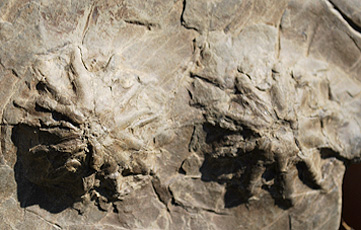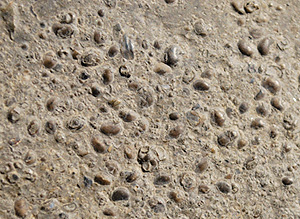The Paleontology (Fossils) of Blue Beach: (an overview)
Rocks of Lower Carboniferous age (approx. 350 mya.) of The Horton Bluff Formation exposed along the shore at the type-section, at Blue Beach, yield a well-preserved assortment of trace fossils and body fossils. Every fossil site is a unique glimpse of the environment and life present at the time of its making. The environment of Blue Beach can be described as an ancient shoreline of a large bay or estuary that had some limited connection to the sea.

Rhizodontid tooth

Unusual preservation of two Archaeocalamites
The water was not fully fresh like a lake, nor fully salt like the ocean – rather it would be more like the Florida Everglades of today. The climate was tropical with primitive forests and fetid swamps.
Blue Beach is what we call a ‘classic’ fossil site with its diverse vertebrates, invertebrates, plants and traces. What makes it so special is the remarkable age of 350-million years ago (mya.), right in the middle of an enigma that has been named “Romer’s Gap”, considered by many to be Evolution’s Greatest Mystery.
Being a classic vertebrate locality, Blue Beach is known to contain all the typical elements of the later Carboniferous tetrapod and fish faunas. These are summarized below. For greater detail, choose by clicking on the sections above.
Vertebrate animals
- Tetrapods left both their abundant footprints (traces) and rare bony remains here. At least five species were present. These are all are new to science. These are stem tetrapods, including temnospondyls, whatcheeriids, anthracosaurs, with possibly the last known relict of an acanthostegid-grade tetrapod.
- Lobe-finned Fishes (Sarcopterygii) include a very abundant rhizodontid (Letognathus) and rare lungfishes (?Ctenodus). The rhizodont grew up to five meters long.
- Small ray-finned Fishes known as palaeoniscoids are very common finds and show that the group had attained a remarkable diversity during the Early Carboniferous.
- Primitive shark-like Creatures known as the acanthodians (gyracanthids, climatiids, acanthodiids) and and at least one true shark (Ctenacanthus) were also abundant. Usually fairly small, one of these grew up to five meters long.
Invertebrate animals
The only body fossils are those of ostracod crustaceans (numerous), spirorbid worms (rare), and the horseshoe crab Euproops (rare). Evidence of invertebrate life at Blue Beach comes mainly in the form of their trace fossils (trails, tunnels and burrows). The trace fossils hint at a diverse community with scorpionids, undetermined arthropods, and a variety of undetermined worms. Until now, this peculiar style of invertebrate community was not believed to have colonized terrestrial ecosystems before the Permian period (290 mya.).

Ostracods: the most common invertebrates
Romer’s Gap
Fossil sites before Romer’s Gap (375-360 mya.) show a few primitive tetrapods who seem to eventually become extinct. They clearly weren’t the true predecessors of the true ‘land-animal groups’.
Fossil sites after Romer’s Gap (340 mya.) show an early mixture of these land-animals, the oldest recorded representatives of today’s land-animals. These early tetrapods were only known to date back to about 340 mya. The intervening 25 million years or so is famous for providing not one single tetrapod fossil, not even a tooth, from any locality on Earth.
Blue Beach has for many years been the only site where tetrapods in this gap were being found. Recent discoveries in Scotland (see “In the News”) are now helping widen the door to our understanding. Current research into these important Scottish and Blue Beach discoveries are together altering our theories on the very first colonization of land.
Body Fossils
Body fossils are the actual remains of ancient plants and animals. Bones, shells, stems or leaves are normal examples and they may be mineralized, coalified or merely exist as impressions or compressions of the original biological material.
Trace Fossils
Trace fossils are not actual things, but rather they are some trace of an act. Examples include tracks, trails, tunnels, burrows and also things like fecal matter (coprolites).